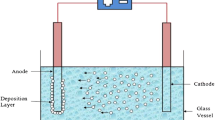Abstract
Electrohydraulic forming (EHF) method is used extensively in industrial applications for its high capacity in improving the formability of various sheet metals. EHF is a high-velocity sheet metal forming process in which two electrodes are positioned in a water-filled chamber and a high-voltage discharge between the electrodes generates a high pressure to form the sheet metal. The EHF method contains innate complexity and depends on different parameters. Then, it is essential to investigate the process thoroughly and present the experiment procedure in such a way that an optimum condition can be met. In the present study, the effective parameters of the EHF (with and without using bridge wire) on free forming of circular Brass 260 sheets are analyzed by employing the design of experiment technique. Numerous experimental tests are performed, and the process parameters are optimized implementing response surface methodology and Minitab software. The most affective parameters were determined by analysis of variance method. Based on the results for EHF without using wire, it can be stated that maximum dome height is obtained when discharge energy is maximum and other two factors (stand-off distance and electrode diameter) are minimum. There also exists an optimum amount of electrode gap determined according to the process conditions. In case of EHF using wire, it was found that the aluminum wire was more efficient than copper and tungsten. Also, there are optimum values for the length and diameter of bridge wire that depended on the experimental conditions.

























Similar content being viewed by others
References
Hajializadeh F, Mashhadi MM (2015) Investigation and numerical analysis of impulsive hydroforming of aluminum 6061-T6 tube. J Manuf Process 20:257–273
Luchinskii A (1989) Electrical explosion of wires. Nauka, Moscow
Robinson JW, Ham M, Balaster AN (1973) Ultraviolet radiation from electrical discharges in water. J Appl Phys 44(1):72–75
Lane T (1767) Description of an electrometer invented by Mr. Lane; with an account of some experiments made by Him with it: in a letter to Benjamin Franklin, LL. DFRS. Philos Trans 57:451–460
Priestley J (1769) Experiments on the lateral force of electrical explosions. By Joseph Priestley, L LDFRS. Philos Trans 59:57–62
Yutkin L (1955) Electrohydraulic effect, Mashgiz, Moscow, Translation No. AD-722, Armed Services Technical Information Agency, Arlington Hall Station, Arlington, VA
Davies R, Austin ER (1970) Developments in high speed metal forming. Industrial Press, New York
Chachin V (1978) Electro-hydraulic processing of engineering materials. Minsk Sci Eng 1978:184 (in Russian)
Oyane M, Masaki S (1964) Fundamental study on electrohydraulic forming. Bull JSME 7(26):474–480
Coman L (2010) The influence of some factors on maximum depth in electrohydraulic forming. Analele Universităţii “Eftimie Murgu” Reşiţa, anul XVII, Nr2, 2010, ISSN 1453-7397 (2):93–98
Coman L (2011) Using the initiation system of electrical discharge in the case of electrohydraulic forming. UEM J 3:93–100
Knyazyev M, Zhovnovatuk YS (2010) Measurements of pressure fields with multi-point membrane gauges at electrohydraulic forming. In: 4th international conference on high speed forming, March 9th–10th 2010 Columbus, Ohio, USA. Institut für Umformtechnik-Technische Universität Dortmund
Knyazyev M, Perez I, San José J, Zhovnovatyuk Y (2012) Pressure fields repeatability at electrohydraulic pulse loading in discharge chamber with single electrode pair. In: 5th international conference on high speed forming, April 24th–26th 2012, Dortmund, Germany
Hasebe T, Takenaga Y, Kakimoto H, Imaida Y (1999) High strain rate forming using an underwater shock wave focusing technique. J Mater Process Technol 85(1):194–197
Sayapin A, Grinenko A, Efimov S, Krasik YE (2006) Comparison of different methods of measurement of pressure of underwater shock waves generated by electrical discharge. Shock Waves 15(2):73–80
Golovashchenko SF, Gillard AJ, Mamutov AV (2013) Formability of dual phase steels in electrohydraulic forming. J Mater Process Technol 213(7):1191–1212
Samei J, Green DE, Golovashchenko S, Hassannejadasl A (2013) Quantitative microstructural analysis of formability enhancement in dual phase steels subject to electrohydraulic forming. J Mater Eng Perform 22(7):2080–2088
Toshimi T, Masana K, Obara H (1978) Energy consumption at underwater exploding-wire gap in electric discharge metal forming. Bull JSME 21(162):1780–1786
Chace WG, Moore HK (2014) Exploding wires, vol 4. Springer, Berlin
Toshimi T, Masana K, Obara H (1979) Metal forming by underwater wire explosion: 1. An analysis of plastic deformation of circular membranes under impulsive loading. Bull JSME 22(164):271–278
Tobe T, Masana K, Obara H (1984) Metal forming by underwater wire explosions: 2. Experiments on bulging of circular aluminum sheets by copper wire explosions. Bull JSME 27(223):130–135
Toshimi T, Masana K, Obara H (1979) Pressure pulses produced by underwater wire explosions in electric discharge metal forming. Bull JSME 22(166):613–619
Montgomery DC (2008) Design and analysis of experiments. Wiley, London
Bjørnø L, Levin P (1976) Underwater explosion research using small amounts of chemical explosives. Ultrasonics 14(6):263–267
McGrath JR (1966) Scaling underwater exploding wires. J Appl Phys 37(12):4439–4443
Author information
Authors and Affiliations
Corresponding author
Additional information
Technical Editor: Márcio Bacci da Silva, Ph.D.
Rights and permissions
About this article
Cite this article
Zohoor, M., Mousavi, S.M. Evaluation and optimization of effective parameters in electrohydraulic forming process. J Braz. Soc. Mech. Sci. Eng. 40, 524 (2018). https://doi.org/10.1007/s40430-018-1449-1
Received:
Accepted:
Published:
DOI: https://doi.org/10.1007/s40430-018-1449-1




